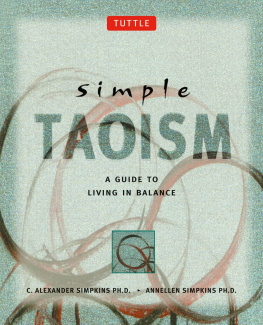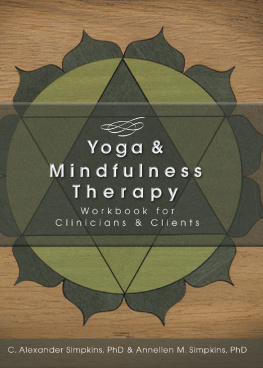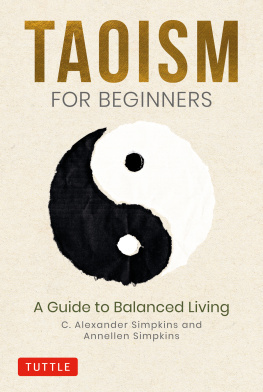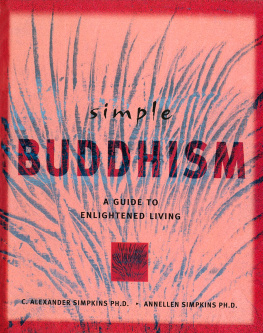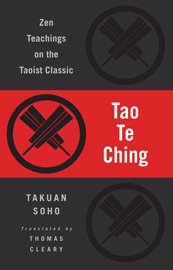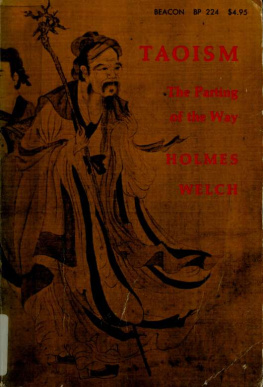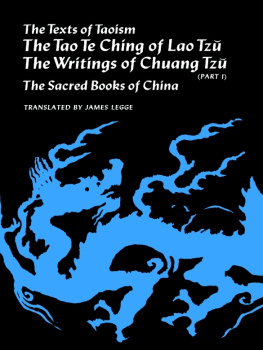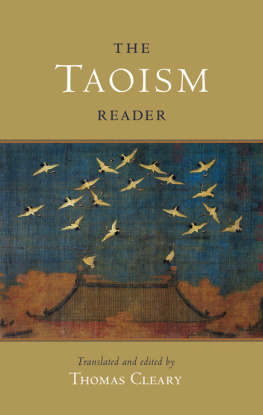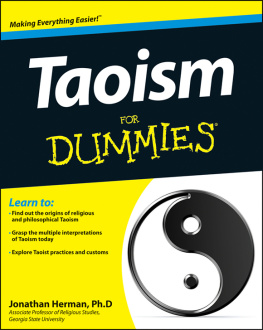A RT IN S IMPLE T AOISM
Bamboo Grove , on page
To-tsz Sun
Chinese, 1962
Ink and colors on paper
Courtesy of the San Diego Museum of Art
Empress Chang Blessed by Taoist Deities (Empress Hung-chis wife) (detail)
Unknown court painters
Chinese, Hung-chi period 1488-1505
Ink and color on paper handscroll
Courtesy of the San Diego Museum of Art
Birds and Rabbits in Snow (detail)
(attributed to) Shu-hsi Chou
Chinese, early Ching dynasty c. 1620-c. 1700
Ink and colors on silk
Courtesy of the San Digo Museum of Art
BIBLIOGRAPHY
Atkinson, B., ed. 1965. Walden and Other Writings of Henry David Thoreau. New York: Random House.
Birren, F. 1961. Creative Color. New York: Van Nostrand Reinhold Company.
Blofeld, J. 1966. The Book of Change. New York: E.P. Dutton & Co., Inc.
Capra, F. 1977. The Tao of Physics. New York: Bantam Books.
Chan, P. 1982. How to Free Yourself from Pain. Los Angeles: Price, Stern, Sloan.
Chan, W. T. 1963. A Sourcebook in Chinese Philosophy. Princeton, N.J.: Princeton University Press.
Chang Chung-yuan. 1963. Creativity and Taoism. New York: Harper Colophon Books.
Chang Po-tuan. 1987. Understanding Reality: A Taoist Alchemical Classic. Honolulu: University of Hawaii Press.
Cleary, T. 1991. Vitality, Energy, Spirit: A Taoist Sourcebook. Boston: Shambala.
Duke, M. 1972. Acupuncture. New York: Pyramid House.
Duyvendak, J. J. L. 1992. Tao Te Ching, The Book of the Way and Its Virtue. Boston: Charles E. Tuttle Co., Inc.
Fogarty, J., trans. 1977. A Barefoot Doctors Manual: The American Translation of the Official Chinese Paramedical Manual. Philadelphia: Running Press.
Frank, J. D., and J. B. Frank. 1991. Persuasion and Healing. Baltimore: The Johns Hopkins University Press.
Freud, S. 1953. The Interpretation of Dreams, vol. IV. Standard Edition of the Complete Psychological Works of Sigmund Freud. 24 Vols. London: Hogarth.
Fudler, S. 1989. The Tao of Medicine. Rochester, Vt.: Destiny Books.
Fung Yu-Lan. 1966. A Short History of Chinese Philosophy. New York: Free Press.
Giles, L. 1959. Taoist Teachings Translated from the Book of Lieh-Tzu. London: John Murray.
Graham, A. 1990. The Book of Lieh-Tzu. New York: Columbia University Press.
Griffith, S. B. 1971. Sun Tzu The Art of War. London: Oxford University Press.
Henricks, R. G. 1989. Lao-tzu Te Tao Ching. New York: Ballantine Books.
Hucker, C. O. 1975. Chinas Imperial Past. Stanford, Calif.: Stanford University Press.
Jung, C. G. 1978. Psychology and the East. Princeton, N.J.: Princeton University Press.
Kaltenmark, M. 1969. Lao Tzu and Taoism. Palo Alto, Calif.: Stanford University Press.
Kaptchuk, T. J. 1983. The Web That Has No Weaver: Understanding Chinese Medicine. New York: Congdon & Weed.
Kaufmann, E., and B. Raeburn, eds. 1960. Frank Lloyd Wright: Writings and Buildings. New York: Meridan Books.
Kwok, M. 1994. Tao Te Ching . New York: Barnes and Noble Books.
Lee Ying-arng. 1968. Lees Modified Tai Chi for Health. Hong Kong: Unicorn Press.
Legge, J. 1962. The Texts of Taoism. 2 Vols. New York: Dover.
_____. 1985. The Chinese Classics, vol. 2. Oxford: Clarendon Press.
Liang, T.T. 1977. Tai Chi Chuan for Health and Self-Defense. New York: Vintage.
Liu, Da. 1986. Tai Chi Chuan and Meditation. New York: Schocken Books.
Mann, F. 1973. Acupuncture: The Ancient Art of Healing and How It Works Scientifically. New York: Vintage.
Okakura, K. 1989. The Book of Tea. Tokyo: Kodansha International.
Palos, S. 1972. The Chinese Art of Healing. New York: Bantam.
Robinet, I. 1993. Taoist Meditation. Albany: State University of New York Press.
Rosen, H. 1977. Pathway to Piaget. Cherry Hill, N.J.: Postgraduate International, Inc.
Saso, M. 1990. Blue Dragon White Tiger: Taoist Rites of Passage. Washington, D.C.: The Taoist Center.
Schipper, K. 1982. The Taoist Body . Berkeley: University of California Press.
Serizawa, K. 1989. Tsubo: Vital Points for Oriental Therapy . Tokyo: Japan Publications, Inc.
Shim, Sang Kyu. 1990. The Religious Nature of the Martial Arts. Tae Kwon Do Times 10, no. 6 (September).
Simpkins, C. A., and A. Simpkins. 1996. Principles of Meditation: Eastern Wisdom for the Western Mind. Boston: Charles E. Tuttle Co., Inc.
_____. 1997. Living Meditation: From Principle to Practice. Boston: Charles E. Tuttle Co., Inc.
_____. 1998. Meditation from Thought to Action. Boston: Charles E. Tuttle Co., Inc.
_____. 1991. Principles of Self Hypnosis: Pathways to the Unconscious. New York: Irvington
Siren, O. 1963. The Chinese on the Art of Painting. New York: Schocken Books.
Small, H., ed. 1947. Form and Function: Remarks on Art by Horatio Greenough. Berkeley and Los Angeles: University of California Press.
Staff of the Peoples Medical Publishing House of Beijing, China. 1984. The Chinese Way to a Long and Healthy Life. New York: Bell Publishing Company.
Ssu-ma, Chien, and W. H. Nienhauser, ed. 1994. The Grand Scribes Records. Vol. I. Bloomington: Indiana University Press.
_____. 1994. The Grand Scribes Records. Vol.VII. Bloomington: Indiana University Press.
Sze, M. 1959. The Way of Chinese Painting. New York: Vintage Books.
Waley, A. 1958. The Way and Its Power. New York: Grove Weidenfeld.
Watanabe, J., and L. Avakian. 1984. Secrets of Judo. Rutland, Vt.: Charles E. Tuttle Co., Inc.
Watts, A. 1975. Tao : The Watercourse Way. New York: Pantheon Books.
Welch, H. 1967. Taoism, the Parting of the Way . Boston: Beacon Press.
Westwood, A., and O. Ratti. 1980. Aikido and the Dynamic Sphere. Rutland, Vt.: Charles E. Tuttle Co., Inc.
Wilhelm, H., and R. Wilhelm. 1995. Understanding the I Ching. Princeton, N.J.: Princeton University Press.
Wilhelm, R. 1990. Tao Te Ching, The Book of Meaning and Life. London: Arkana.
Wong, E. 1997. Harmonizing Yin and Yang: The Dragon-Tiger Classic. Boston: Shambala.
Wright, F. L. 1970. The Natural House. New York: Meridan Books.
Yang Jwing-ming. 1982. Yang Style Tai Chi Chuan. Los Angeles: Unique Publications.
_____. 1986. Advanced Yang Style Tai Chi Chuan. Vol. I. Boston: Yangs Martial Arts Academy (YMAA).
Yutang, L., ed. 1942. The Wisdom of China and India. New York: Random House.
_____. 1948. The Wisdom of Laotse. New York: The Modern Library.
CHAPTER 1
Origins and Background
There is in the Changes the Great Primal Beginning (Tai Chi). This
generates the two primary forces. The two primary forces generate the
four images. The four images generate the eight trigrams.
I Ching, Chapter , in Liu 1986, 24
Much of what is known of early Chinese philosophies comes from the work of two famous historians, father and son, Ssu-ma Tan (d. 110 B.C.) and his son Ssu-ma Chien (14586 B.C.). Ssu-ma Tan was the historian of the Royal Library. Ssu-ma Chien wrote an extensive history entitled Records of the Historian . The records and writings of these two men have helped historians through the ages piece together the often vague background of Chinas great philosophies.
E ARLY B ELIEFS
The foundation of Chinese thought is the belief in a single cosmic universe, a Oneness with no beginning or end. Older than any of the schools of Chinese philosophy were certain basic beliefs that helped the Chinese understand themselves in relation to the world: in the beginning, the world was an endless void called Wu Chi. It was pictured as an empty circle formed by dotted lines. From this arose activity, expressed as yang and shown as an empty circle, and inactivity, expressed as yin, and shown as a black circle. The interactions of activity and inactivity are called tai chi, shown as the famous yin-yang circle, half black and half white (See Figure ).
Next page
